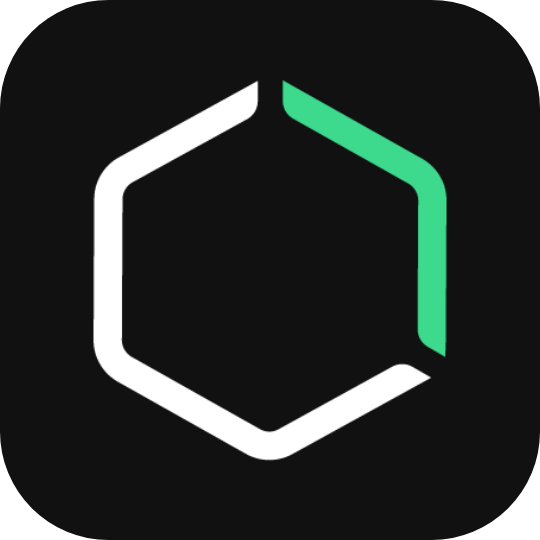What superpower would you choose if you could have one? The idea of letting go of our limitations for just one moment and thinking more about what we could be seems possible only in the hypothetical. But magical things can happen when we apply this mindset to our leadership aspirations.

Have you ever sat down and really considered what type of leader you want to be tomorrow instead of only considering what type of leader you are today? More importantly, when is the last time you took that goal and actually moved towards it?
Reach your leadership goals in just 2 minutes a day! Get early access to the Bunch leadership coach.
Self-assessments of your leadership type and capabilities can be a unique and helpful way of setting goals and striving towards improvement. But they’re not one-and-done evaluations. Life is so much more dynamic than that. That’s why we need to think of any leadership archetypes as north stars. We point ourselves in the right direction and do our best to get there.
The Bunch leadership coach assigns you one of 14 such leadership north stars. While they’re all based on the same framework, they each carry unique characteristics. There’s a lot of ground to cover, so you can use these links to jump around:
- Where did the profiles come from?
- What are the 14 types of leadership?
- How do the profiles align with the Bunch leadership coach?
- How do the leadership types relate to each other?
- How do I choose a leadership profile?
- Parting thoughts on leadership and growth
Leadership Types 101: Where did the profiles come from?
Before we get too far into the profiles themselves, we should chat a bit about the foundation for them. During onboarding for the Bunch leadership coach, you go through a quick self-assessment that generates your personal leadership type. These don’t come from thin air.
Each profile is based on the cultural framework developed by Charles O’Reilly (Stanford GDB). You can read extensively about his 6 dimensions of company culture if you’d like, but for this context we can stay a bit more high-level. According to O’Reilly and his team, the 6 dimensions of culture are adaptability, collaboration, customer-orientation, results-orientation, detail-orientation, and focus on principles.
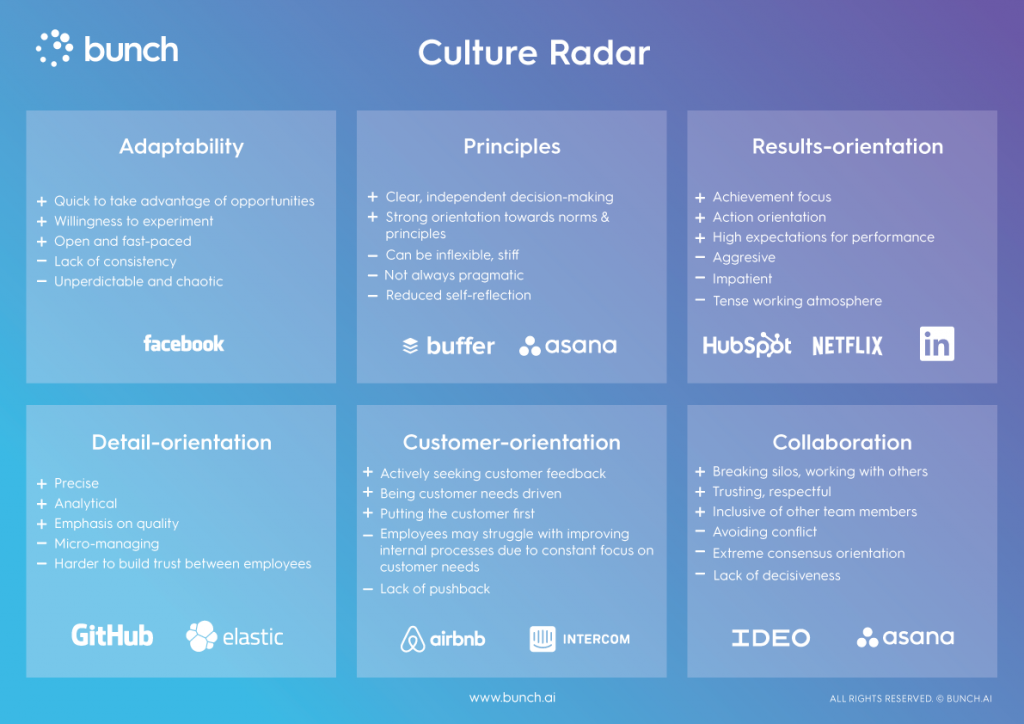
Understanding the cultural dimensions inherently helps us to understand our values and priorities, which drive behavior. Just as there are unique dimensions for culture, there are also unique profiles within them. All 14 Bunch leadership types map back to a similar universe because they are based on this framework.
The main difference between a typical personality assessment and the Bunch leadership profiling (not a personality) is that our assessment is based on a norms evaluation. That means it’s not something that’s glued to you forever.
In fact, the Bunch leadership type is as flexible as you are. As leaders, we are all dynamic, changing every day, week, and month and the Bunch profile reflects that. Rather than understanding it as static, the idea is that you will likely move through different profiles over time.
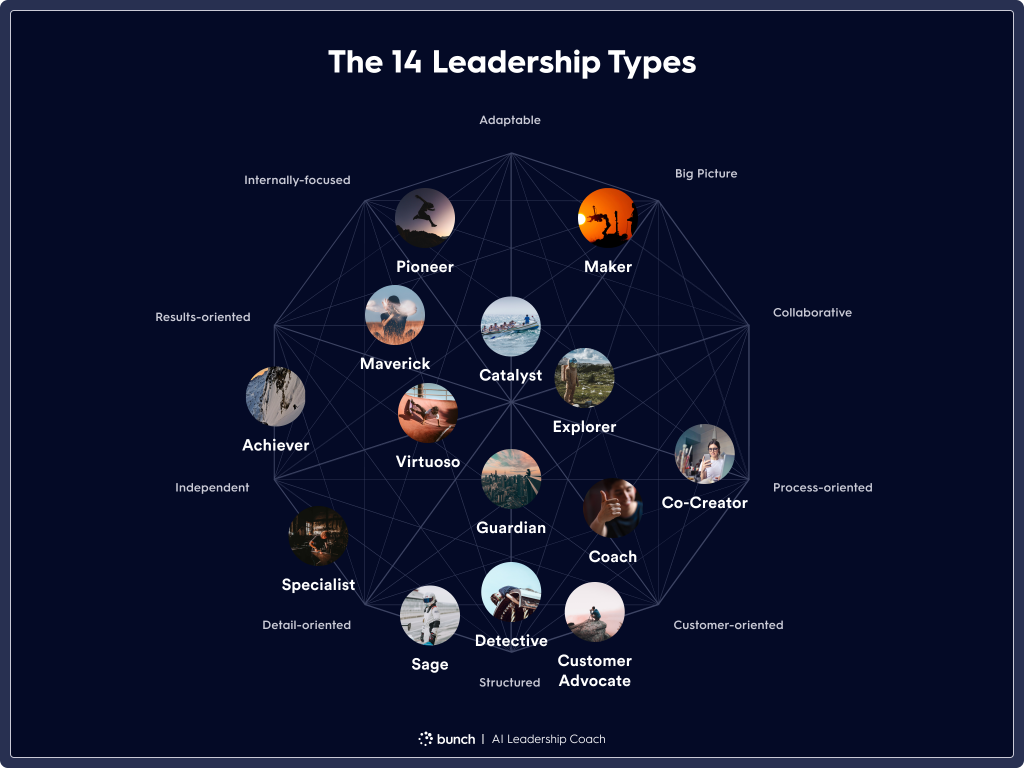
What are the 14 types of leadership?
So now that the origin story is clear, we can dive into the profiles themselves. Each leadership type is based on key characteristics and exhibits certain strengths and weaknesses. They also tend to have certain skills and things to look out for.
The Maker
This leader is a cooperative problem-solver who is comfortable working in changing environments. Potential problem areas for this type include avoiding conflict and needing clear boundaries between group and independent work. This profile is both adaptable and collaborative.
The Maverick
This leader is quick to respond to change who isn’t afraid of making decisions independently. Potential problem areas for this type include being unpredictable or moving ahead without getting buy-in from the team. This profile is both adaptable and independent.
The Coach
This leader is a true team spirit who thrives when working with others. Potential problem areas for this type include requiring more evidence to commit to decisions and needing clear boundaries between group and independent work. This profile is both structured and collaborative.
The Sage
This leader is focused and efficient and can always be trusted to deliver on time. Potential problem areas for this type include difficulty staying productive without a clear plan and moving ahead without getting buy-in from the team. This profile is both structured and independent.
The Explorer
This leader is an innovator who loves to discover new ways of engaging customers. Potential problem areas for this type include advocating for customers at the expense of other needs and avoiding conflict. This profile is both customer-oriented and adaptable.
The Customer Advocate
This leader is reliable and approachable, always striving to represent the voice of the customer. Potential problem areas for this type include advocating for customers at the expense of other needs and requiring more evidence to commit to decisions. This profile is both customer-oriented and structured.
The Co-Creator
This leader is a customer guru who excels at bringing people together. Potential problem areas for this type include advocating for customers at the expense of other needs and needing clear boundaries for group and independent work. This profile is both customer-oriented and collaborative.
The Detective
This leader is a true ambassador of customer needs and always delivers a high-quality service. Potential problem areas for this type include advocating for customers at the expense of other needs and holding themselves to unrealistically high standards. This profile is both customer-oriented and detail-oriented.
The Pioneer
This leader is known for entrepreneurial spirit and can quickly change tactics to hit goals. Potential problem areas for this type include impatience and unpredictability. This profile is both results-oriented and adaptable.
The Catalyst
This leader is strong in execution and motivates the team to hit even the most challenging goals. Potential problem areas for this type include impatience and needing clear boundaries for group and independent work. This profile is both results-oriented and collaborative.
The Achiever
This leader is the first to notice and jump on new opportunities, frequently a starter of movements. Potential problem areas for this type include impatience and moving ahead without getting buy-in from the team. This profile is both results-oriented and independent.
The Virtuoso
This leader is quick to suggest new ideas and approaches, and unable to resist a good challenge. Potential problem areas for this type include pursuing new ideas without getting buy-in from the team and having high work standards that can be difficult to reach. This profile is both detail-oriented and adaptable.
The Guardian
This leader is a committed team player, always striving for quality over quantity. Potential problem areas for this type include a lack of willingness to compromise on quality and needing clear boundaries for group and independent work. This profile is both detail-oriented and collaborative.
The Specialist
This leader is reliable and autonomous, providing in-depth expertise in critical areas. Potential problem areas for this type include getting caught up in details and moving ahead without getting buy-in from the team. This profile is both detail-oriented and independent.
Want to discover your leadership type? Get early FREE access to the Bunch app to get your profile.
How do the leadership types relate to each other?
Each leadership profile is distinct from the others, but they often share some common qualities, since they are based on the same 6 culture norm dimensions of O’Reilly. To make this clear, we’ve grouped them into families. Some profiles lie across multiple families, which just speaks to the elasticity they contain.
As you explore each family, take note of the variants between the profiles and start to think about your priorities. Is there anything that strikes you about a particular profile? Maybe you’ll be able to immediately identify with one or see your future self aligning with its skills. Looking to neighboring profiles can be a great way of targeting what’s important to you, but still similar to your natural style (if that’s not the profile you have already).
You may also find that the profile you strive to align with in the future is not in the family where your current profile lives. Don’t worry, it’s not impossible to jump to a new family. However, choosing a profile that’s radically different from where you naturally settle may just be a longer-term goal.
The Shapeshifters
These leaders are masters of speed, change, and learning. Their teams are great at learning quickly and they iterate on almost a daily basis. “Change” is their middle name and you can always rely on them to take advantage of almost every opportunity.
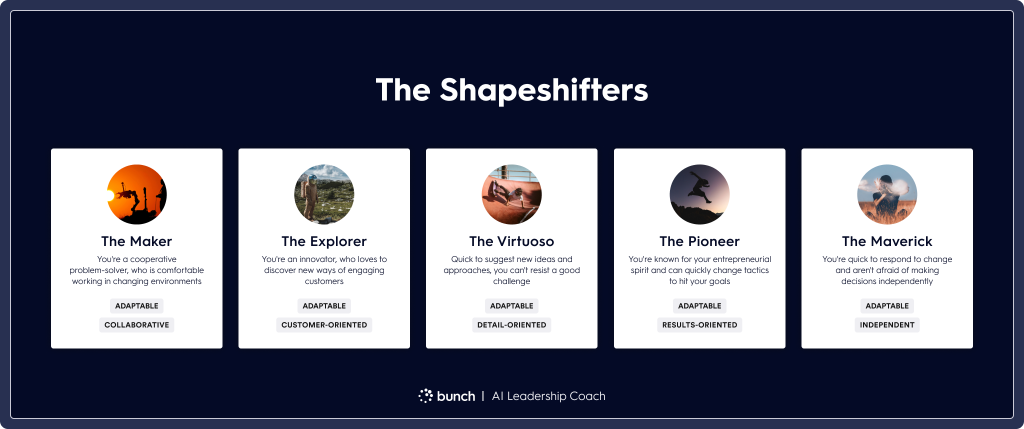
The Hustlers
These leaders are wizards when it comes to making it happen. You can rely on them to always, always, always get the job done! They are true executers and you’ll always get the bang for your buck with them.
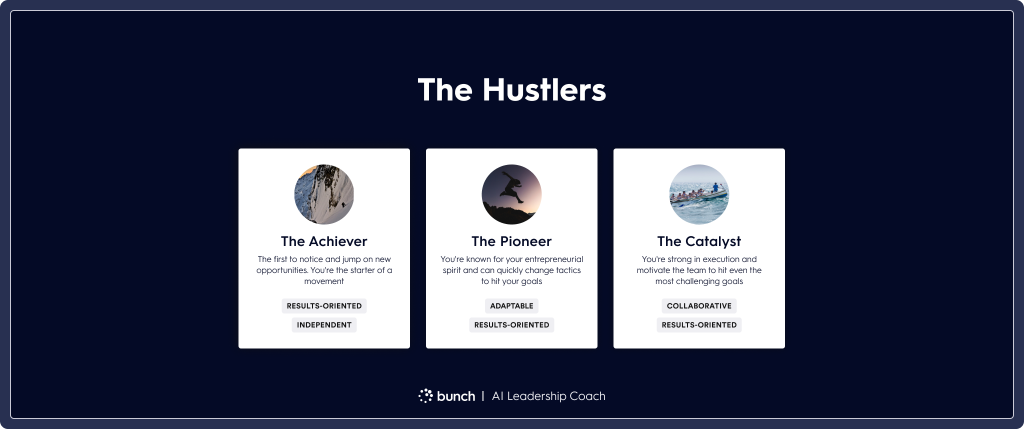
The Precision Artists
These leaders are masters of perfection. They know that great things take time and they help their team to truly deliver outstanding results. They are not usually as interested in optimizing for speed. But when you slow down to speed up, they really can make wonders happen.
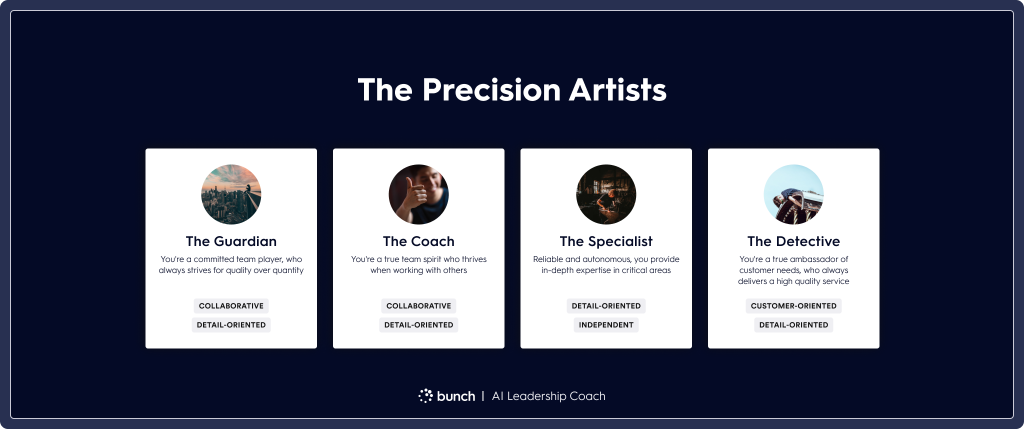
The Customer Heroes
These leaders are customer and user whisperers. They will never ever (ever) lose sight of customer value and know that no matter how good things are, we can always be doing better for our customers. They are the source of wisdom when it comes to customer needs and perspective, and they know how to structure the best customer interviews.
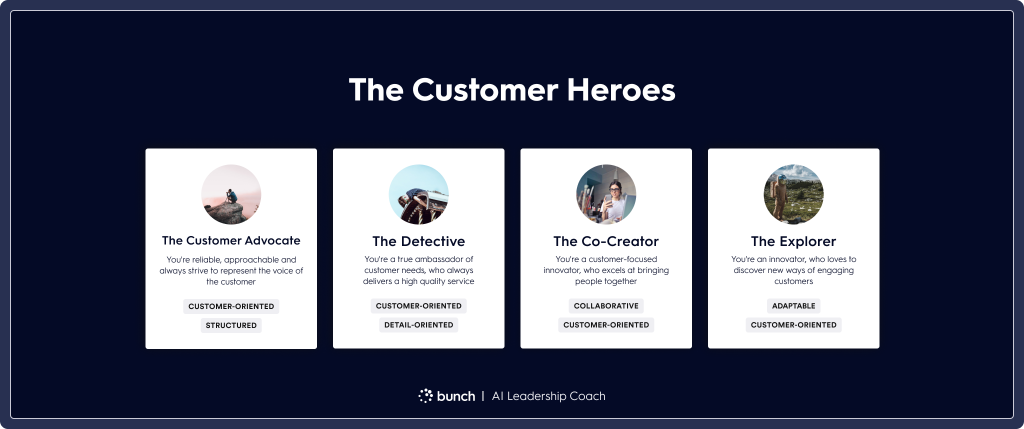
The Team Players
These collaborative leaders are true team players. They make everyone around them light up. When they are on vacation even just for a week, you can feel their lack of presence and morale may suffer. They are the soul of their team.
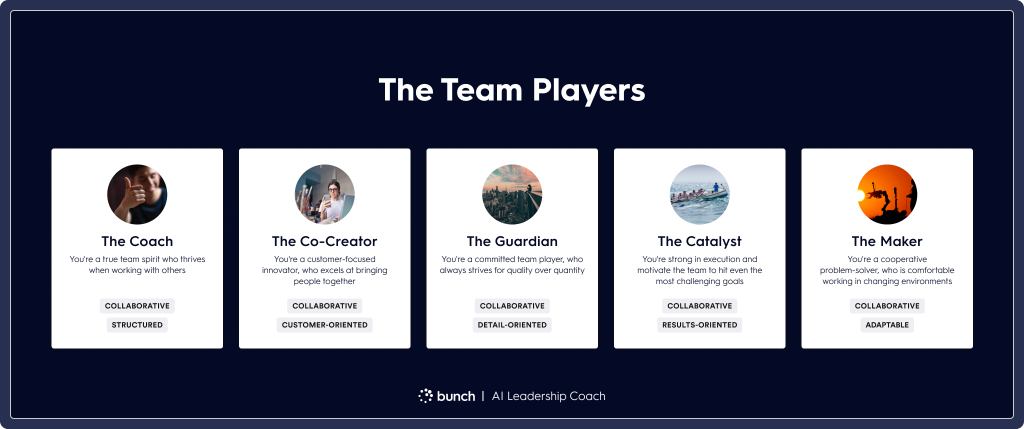
The Trail Blazers
These leaders are independent and respected for their ability to make quick decisions on their own. They are not susceptible to harmful influences and inspire autonomy and empowerment in those around them.
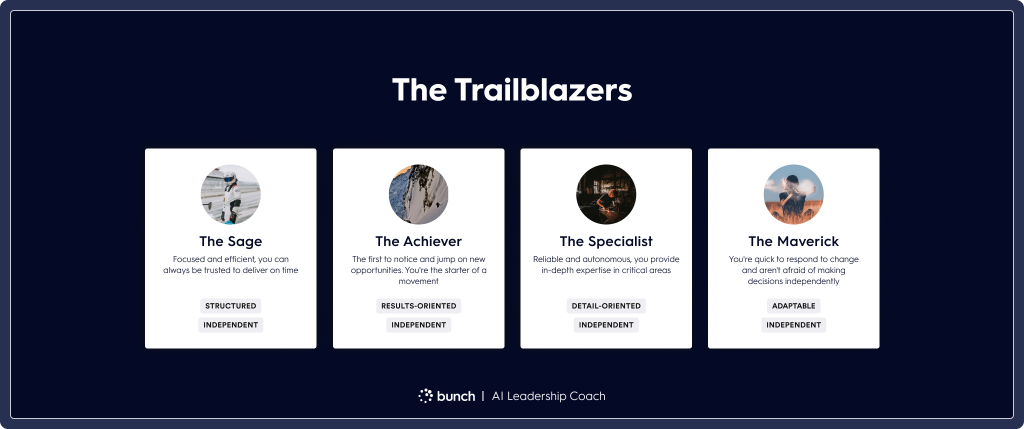
The Stabilizers
These leaders are structured and will definitely make sure that your systems scale. Everything has its place according to them, so you’ll grow on a strong and stable foundation.
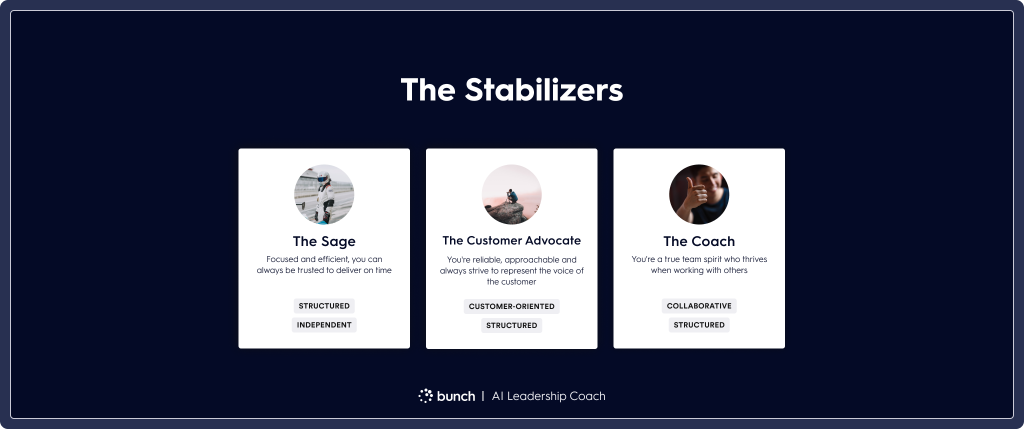
How do the profiles align with the Bunch leadership coach?
All profiles have their superpowers and their downers. Which makes sense because you’ll never be able to be everything to everyone. The key is to know what you value and therefore emphasize, and deprioritize what doesn’t matter to you as much.
It’s important to make one thing clear: just because you’ve been given a profile doesn’t mean you have every single aspect of it in the current moment. It’s mostly a guide for self-reflection (and reflection on your relationships). These are archetypes and help us with alignment and goal-setting. I cannot stress enough that the leadership types aren’t personalities. They should instead function as guides, helping you to explore your overarching leadership growth journey.
If you’re not satisfied with your shortcomings, it’s always an option to grow and develop your weak points or target new superpowers to acquire. That’s actually the idea behind the Bunch coach, as it helps you to understand who you are today, define where you want to be tomorrow, and then get you there. It all comes in bite-sized, actionable tips so that you can get to who you want to be as a leader step-by-step and day-by-day.
Reach your leadership goals in just 2 minutes a day! Get early FREE access to the Bunch leadership coach.
Choose your hero: who’s the leader you want to be?
Now that you’re a bit more intimate with the profiles, let’s do a thought experiment. I want you to consider a few different components of not just your leadership style, but the outcomes and goals related to it. The scope of elements we’ll look at range from granular to big picture.
First, we’ll look at the present moment:
- What are your strengths? If you’re not sure, look for patterns in your day-to-day. Maybe you’re frequently complimented on your attention to detail in projects, or given feedback on your collaborative nature.
- What are your areas for improvement? Check some of the feedback you’re getting from your team or some of the moments when you didn’t feel you’d done your best work.
Now, let’s look to the future:
- What types of qualities are important to you? Some ways of exploring this are thinking about leaders you respect and admire and making a list of qualities they exhibit.
- What kind of career path are you hoping to follow? When you think of leadership, think also about the next steps in your professional life. This may provide some clarity on what you need in order to reach those goals.
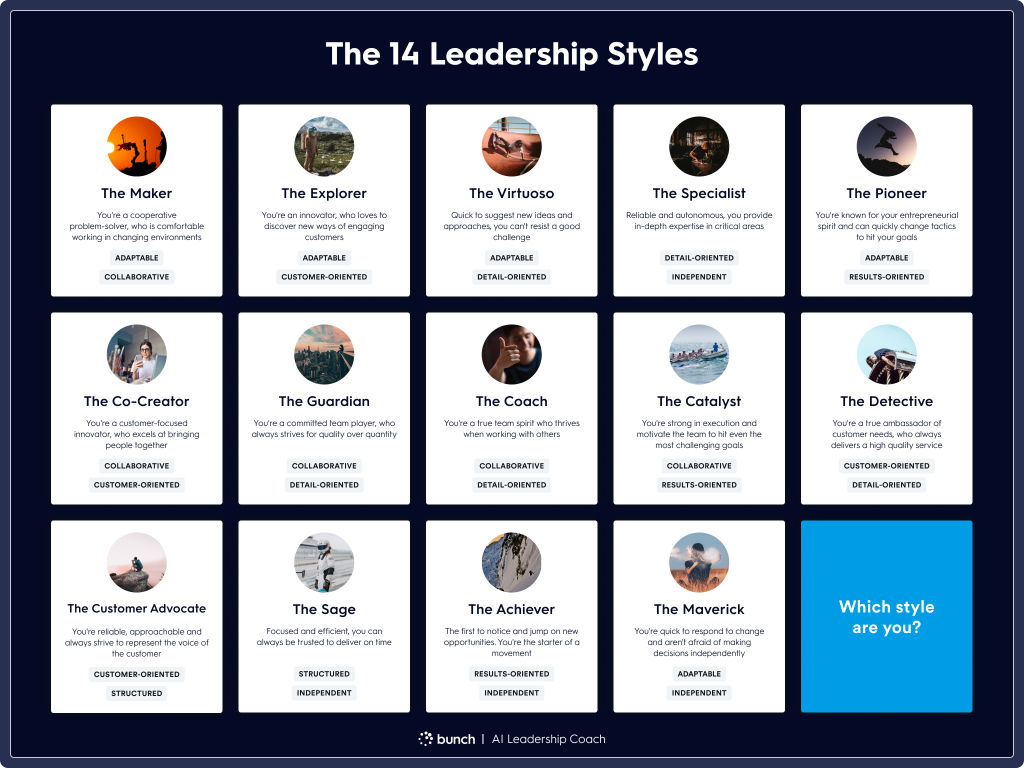
When deciding on your next steps, you can take one of two approaches:
The first is to look at your strengths and ask yourself which additional superpowers you’re interested in developing. Then, look at the profiles that have these skills and select one that suits the goals you’re working towards.
The second requires some reflection on your areas for improvement. If you’ve already identified your shortcomings, think about which ones stand in your way. Then, pick a profile that doesn’t have these weaknesses. Keep in mind that you’ll always have limitations. Once you can accept this, you’ll be able to shift your focus on improving your existing shortcomings and acquiring new superpowers (but also dealing with the new weaknesses that come into play with the new profile).
Some parting thoughts on leadership and growth
Regardless of what you decide is significant for you, choosing a profile is an act of goal-setting itself. Whether you’re happy with the one that’s been given by your Bunch coach or you choose one you aspire to be like, committing to your profile means committing to your goals. As you develop and grow, so will your leadership profile.
While working on your areas of improvement or changing your leadership style is certainly not an easy task, it’s also not an impossible one. Let’s throw the notion that we don’t have control over our leadership capabilities out the window, shall we? Ever wondered what will happen if you commit to your growth path 100%?
Ready to reach your leadership goals? Talk to your Bunch coach to lock in your personalized tips.
